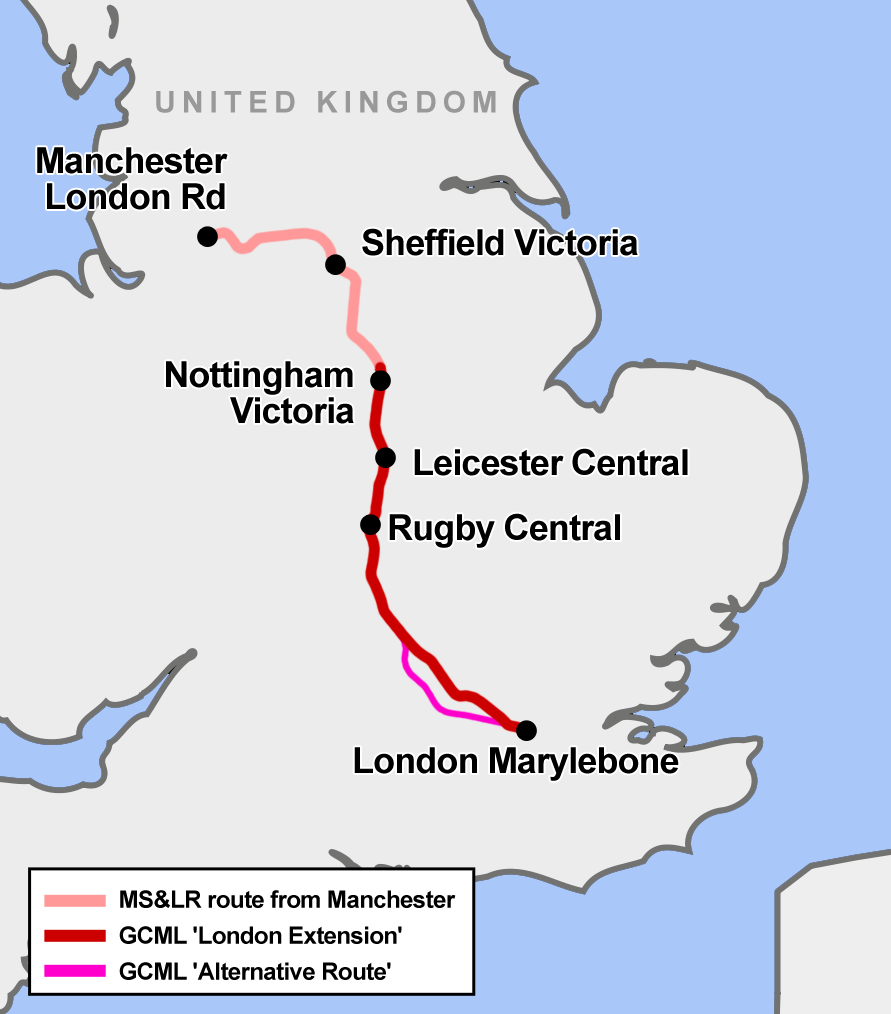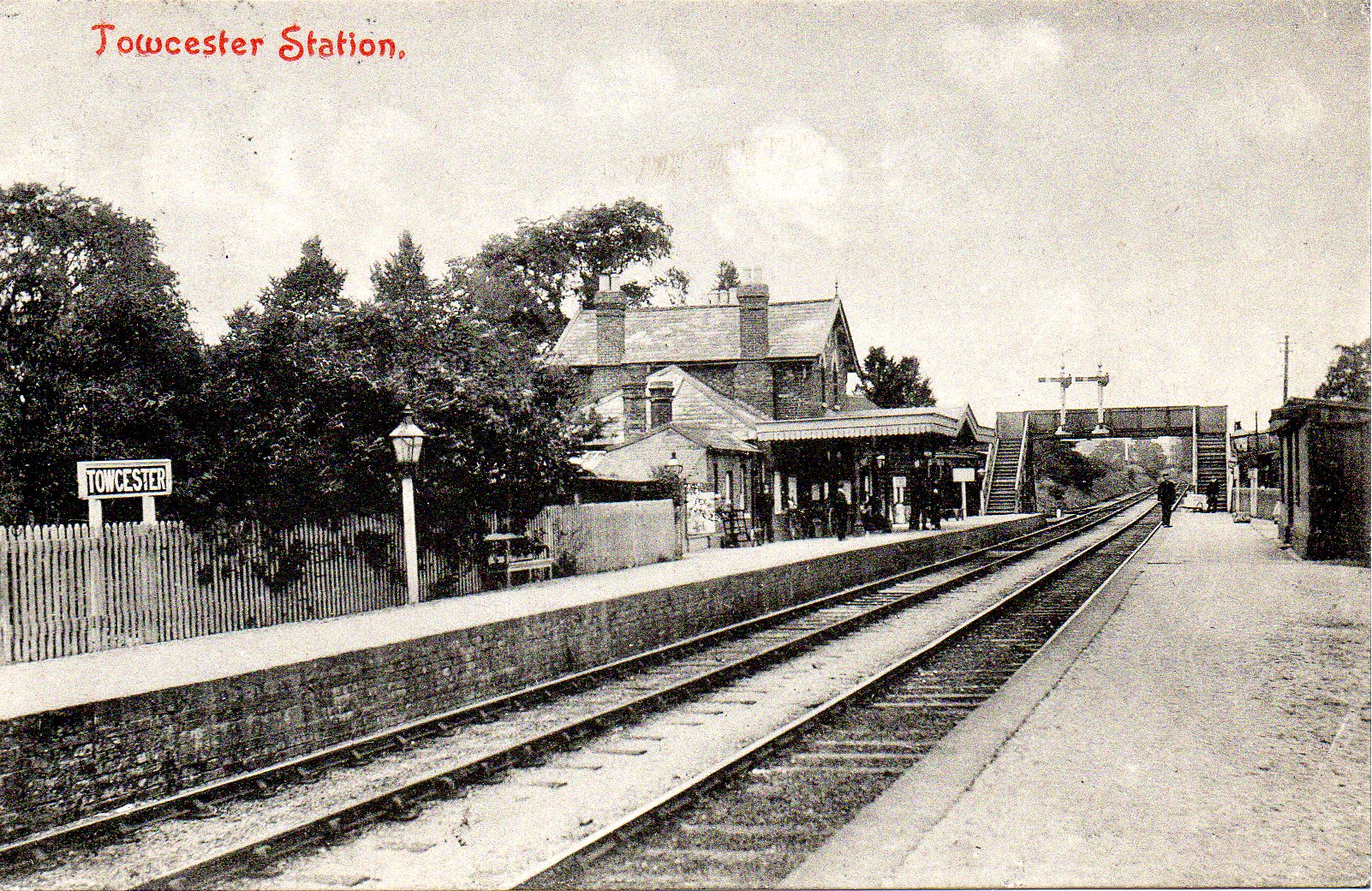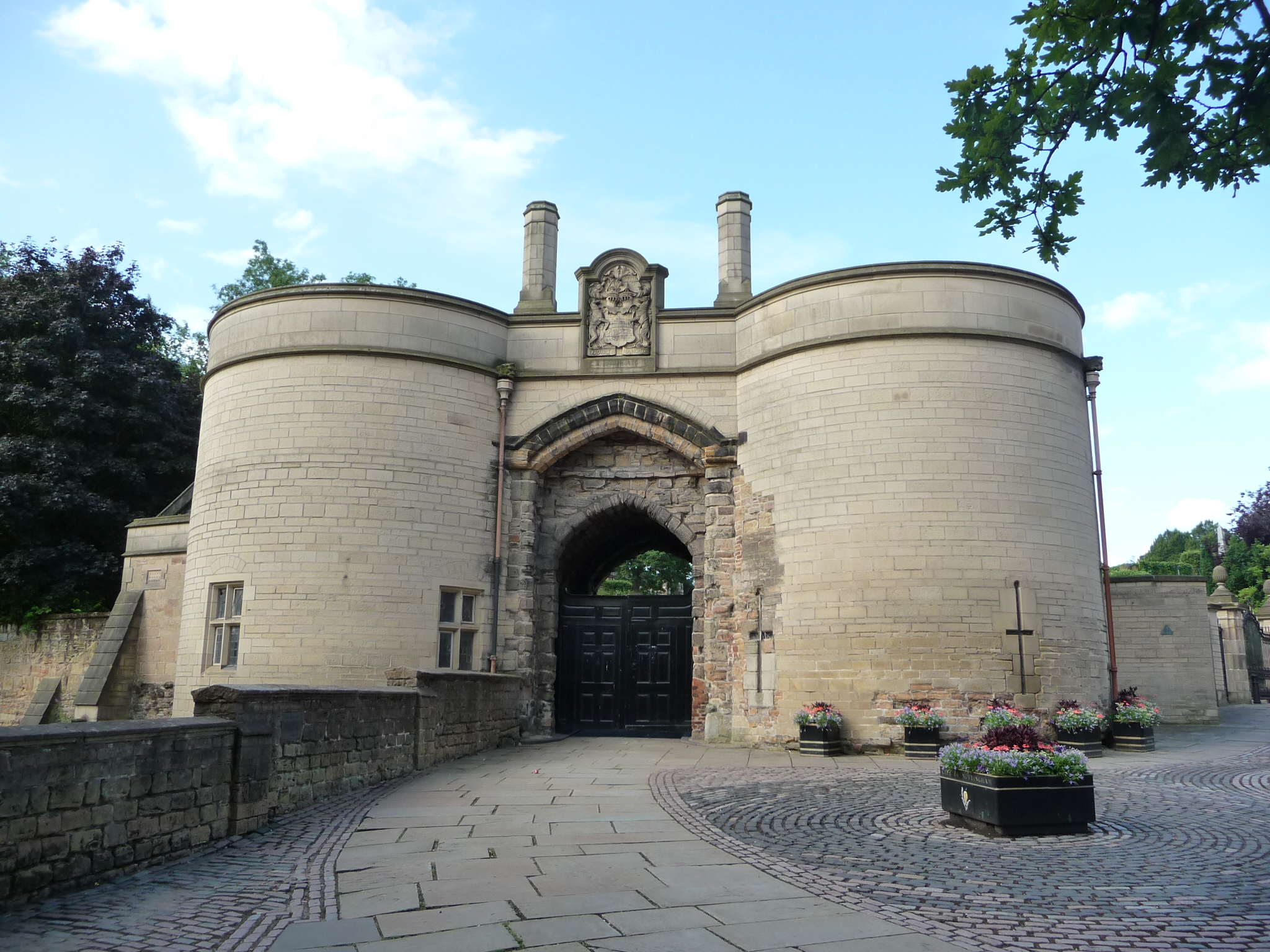|
Great Central Main Line
The Great Central Main Line (GCML), also known as the London Extension is a former main line railway in the United Kingdom. The line was opened in 1899, built by the Manchester, Sheffield and Lincolnshire Railway (MS&LR), which had been renamed the Great Central Railway (GCR) in August 1897, prior to the line's opening. It ran from Sheffield Victoria railway station, Sheffield in the North of England, southwards through Nottingham Victoria railway station, Nottingham and Leicester Central railway station, Leicester to Marylebone station, Marylebone in London. The GCML was the last main line railway to be built in Britain during the Victorian era, Victorian period. It was built by the railway entrepreneur Edward Watkin with the aim to run as a fast trunk route from the North and the East Midlands to London and the south of England. Initially not a financial success, it recovered under the leadership of Sam Fay. Although initially planned for long-distance passenger services, in pra ... [...More Info...] [...Related Items...] OR: [Wikipedia] [Google] [Baidu] |
Braunston And Willoughby Railway Station
Braunston and Willoughby railway station was a station on the former Great Central Main Line. It served the small village of Willoughby which it was located next to, and the larger but more distant village of Braunston. The station opened with the line on 15 March 1899. History The station was one of the standard island platform design typical of the London Extension, though here it was the less common "embankment" type reached from a roadway (the A45 Coventry to Daventry road), that passed beneath the line. The station was situated close to the village of Willoughby, Warwickshire, and was originally known as ''Willoughby for Daventry'' although Daventry itself was some five miles to the south east in Northamptonshire and already had a station of its own on another line (the London & North Western branch line from to ). Braunston, also in Northamptonshire, lay between the two, some two miles away and also served by the same LNWR branch that ran through Daventry, but it wa ... [...More Info...] [...Related Items...] OR: [Wikipedia] [Google] [Baidu] |
Richard Beeching
Richard Beeching, Baron Beeching (21 April 1913 – 23 March 1985), commonly known as Dr Beeching, was a physicist and engineer who for a short but very notable time was chairman of British Railways. He became a household name in Britain in the early 1960s for his report ''The Reshaping of British Railways'', commonly referred to as The Beeching Report, which led to far-reaching changes in the railway network, popularly known as the Beeching Axe. As a result of the report, just over were removed from the system on cost and efficiency grounds, leaving Britain with of railway lines in 1966. A further were lost by the end of the 1960s, while other lines were reduced to freight use only. Early years Beeching was born in Sheerness on the Isle of Sheppey in Kent, the second of four brothers. His father was Hubert Josiah Beeching, a reporter with the '' Kent Messenger'' newspaper, his mother a schoolteacher and his maternal grandfather a dockyard worker. Shortly after his birth, ... [...More Info...] [...Related Items...] OR: [Wikipedia] [Google] [Baidu] |
East And West Junction Railway
The Stratford-upon-Avon and Midland Junction Railway (SMJR) was a railway company in the southern Midlands of England, formed at the beginning of 1909 by the merger of three earlier companies: *the ''East and West Junction Railway'', *the ''Evesham, Redditch, and Stratford-upon-Avon Junction Railway'', and *the ''Stratford-upon-Avon, Towcester, and Midland Junction Railway''. In 1910 the ''Northampton and Banbury Junction Railway'' was purchased and an east–west network was formed which linked routes to Bedford and Northampton in the east to lines leading towards Banbury and Gloucester in the west, by way of Towcester and Stratford-on-Avon. The constituent lines had each been built with a view to carrying Northamptonshire iron ore to South Wales and the West Midlands, but they were all unable to finance their planned lines in full. The formation of the in 1909 was in effect a financial reconstruction, but the management of the combined company also showed a certain flair ... [...More Info...] [...Related Items...] OR: [Wikipedia] [Google] [Baidu] |
Rugby, Warwickshire
Rugby is a market town in eastern Warwickshire, England, close to the River Avon, Warwickshire, River Avon. At the 2021 United Kingdom census, 2021 census, its population was 78,117, making it the List of Warwickshire towns by population, second-largest town in Warwickshire. It is the main settlement within the larger Borough of Rugby, which had a population of 114,400 in 2021. Rugby is situated on the eastern edge of Warwickshire, near to the borders with Leicestershire and Northamptonshire. It is the most easterly town within the West Midlands (region), West Midlands region, with the nearby county borders also marking the regional boundary with the East Midlands. It is north of London, east-south-east of Birmingham, east of Coventry, north-west of Northampton and south-south-west of Leicester. Rugby became a market town in 1255. In 1567, Rugby School was founded as a grammar school for local boys but, by the 18th century, it had gained a national reputation and eventuall ... [...More Info...] [...Related Items...] OR: [Wikipedia] [Google] [Baidu] |
Wigston
Wigston, or Wigston Magna, is a town in the Oadby and Wigston district of Leicestershire, England, just south of Leicester on the A5199. It had a population of 32,321 in 2011. Geography Wigston is south of the city of Leicester, at the centre of Leicestershire and the East Midlands. Oadby is to the east, connected by the B582 road. To the west along the B582, or Blaby Road is South Wigston, . The Grand Union Canal runs along a southern route below Wigston from Newton Harcourt , Kilby Bridge , and for several miles through South Wigston, Glen Parva , Blaby and on towards Leicester. Wigston's population of approximately 32,000 live in both the post-war private suburban housing estates surrounding the old town centre, and the 19th century buildings now sandwiched between modern housing developments. The oldest of the post-war developments is Wigston Fields north of Wigston towards Knighton and Leicester; the Meadows and Little Hill estates were developed in the 197 ... [...More Info...] [...Related Items...] OR: [Wikipedia] [Google] [Baidu] |
Loughborough
Loughborough ( ) is a market town in the Charnwood (borough), Charnwood Borough of Leicestershire, England; it is the administrative centre of Charnwood Borough Council. At the United Kingdom 2021 census, the town's built-up area had a population of 64,884. It is the second largest settlement in the county after Leicester. Loughborough is close to the Nottinghamshire border and is also located near Leicester and Derby. Loughborough is also home to the world's largest bell foundry, John Taylor Bellfounders, which produced Great Paul at St Paul's Cathedral; it has also made bells for the Loughborough Carillon, Carillon War Memorial, a landmark in Queens Park. History Medieval The earliest reference to Loughborough occurs in the Domesday Book of 1086, which calls it ''Lucteburne''. It appears as ''Lucteburga'' in a charter from the reign of Henry II of England, Henry II, and as ''Luchteburc'' in the Pipe Rolls of 1186. The name is of Old English origin and means "Luhhede's ''b ... [...More Info...] [...Related Items...] OR: [Wikipedia] [Google] [Baidu] |
Nottingham
Nottingham ( , East Midlands English, locally ) is a City status in the United Kingdom, city and Unitary authorities of England, unitary authority area in Nottinghamshire, East Midlands, England. It is located south-east of Sheffield and north-east of Birmingham. Nottingham is the legendary home of Robin Hood and to the lace-making, bicycle and Smoking in the United Kingdom, tobacco industries. The city is also the county town of Nottinghamshire and the settlement was granted its city charter in 1897, as part of Queen Victoria's Diamond Jubilee celebrations. In the 2021 United Kingdom census, 2021 Census, Nottingham had a reported population of 323,632. The wider conurbation, which includes many of the city's suburbs, has a population of 768,638. It is the largest urban area in the East Midlands and the second-largest in the Midlands. Its Functional Urban Area, the largest in the East Midlands, has a population of 919,484. The population of the Nottingham/Derby metropolitan a ... [...More Info...] [...Related Items...] OR: [Wikipedia] [Google] [Baidu] |
Great Central Main Line Map
Great may refer to: Descriptions or measurements * Great, a relative measurement in physical space, see Size * Greatness, being divine, majestic, superior, majestic, or transcendent People * List of people known as "the Great" * Artel Great (born 1981), American actor * Great Osobor (born 2002), Spanish-born British basketball player Other uses * ''Great'' (1975 film), a British animated short about Isambard Kingdom Brunel * ''Great'' (2013 film), a German short film * Great (supermarket), a supermarket in Hong Kong * GReAT, Graph Rewriting and Transformation, a Model Transformation Language * Gang Resistance Education and Training Gang Resistance Education And Training, abbreviated G.R.E.A.T., provides a school-based, police officer-instructed program in America that includes classroom instruction and a variety of learning activities. The program was originally adminis ..., or GREAT, a school-based and police officer-instructed program * Global Research and Analysis Te ... [...More Info...] [...Related Items...] OR: [Wikipedia] [Google] [Baidu] |
Ruddington
Ruddington () is a large village in the Borough of Rushcliffe in Nottinghamshire, England. The village is south of Nottingham and northwest of Loughborough. It had a population of 6,441 at the United Kingdom census, 2001, 2001 Census, increasing to 7,216 at the United Kingdom census, 2011, 2011 Census and 7,674 in 2021 United Kingdom census, 2021. Ruddington is Twinned cities, twinned with Grenay, Pas-de-Calais, Grenay, France. The village residents have previously conducted high-profile campaigns in an attempt to retain the rural identity as a village and prevent it being subsumed into the adjoining suburban village of Clifton, Nottinghamshire, Clifton and town of West Bridgford. It maintains this through a variety of local amenities such as several shops, schools, public houses, community centre, village hall and churches within the village centre. Settlements There are two urban areas, and a former village within the Civil parish, parish borders. These areas are considered ... [...More Info...] [...Related Items...] OR: [Wikipedia] [Google] [Baidu] |
Great Central Railway (Nottingham)
The Great Central Railway (Nottingham) (formerly known as the Nottingham Heritage Railway) is a heritage railway located at the Nottingham Transport Heritage Centre (NTHC), on the south side of the village of Ruddington, in Nottinghamshire. The route consists of almost of the former Great Central Main Line from Loughborough South Junction (with the Midland Main Line) to Fifty Steps Bridge and the site of Ruddington's former GCR station, plus a branch line from Fifty Steps Bridge to Ruddington Fields station which is located on a former Ministry of Defence (United Kingdom), Ministry of Defence site next to Rushcliffe Country Park. There are stations open to the public at Ruddington Fields (within the main centre site) and at Rushcliffe Halt railway station, Rushcliffe Halt. The GCR(N) aim to re-open the former station at East Leake railway station, East Leake in the longer term. The railway is not connected to Great Central Railway (heritage railway), Great Central Railway (at ... [...More Info...] [...Related Items...] OR: [Wikipedia] [Google] [Baidu] |
Loughborough Central Railway Station
Loughborough Central Station is a railway station on the Great Central Railway and the Great Central Railway (preserved) serving Loughborough. History The station was opened by the Great Central Railway on 15 March 1899, built to the standard GCR arrangement of having an island platform set between the two main running lines. The platforms are long, capable of accommodating consists of up to 6 coaches and/or mail vans. The station buildings are unique on the preserved railway, the only station with a complete canopy, the longest in railway preservation. The station was closed by British Rail under the Beeching Axe, on 5 May 1969. Reopened by the Great Central Railway as part of the restored heritage railway in 1974, train services currently run south from the station to . Within the station complex, the station buildings, original GCR signal box sited to the north, and the three original water tanks are all Grade II listed. Station masters *Walter Tate *P.B. Hand ca. 192 ... [...More Info...] [...Related Items...] OR: [Wikipedia] [Google] [Baidu] |
Great Central Railway (heritage Railway)
The Great Central Railway (GCR) is a heritage railway in Leicestershire, England, named after the company that originally built this stretch of railway. It runs for between the town of Loughborough and a new terminus in the north of Leicester. It has period signalling, locomotives and rolling stock. Four stations are in operation, each restored to a period in the railway's commercial history: (the 1950s); Quorn and Woodhouse railway station, Quorn & Woodhouse (Second World War and the remainder of the 1940s); (Edwardian Era); Belgrave and Birstall railway station#Leicester North, Leicester North (the 1960s). Between 2006 and 2023 there were four accidents involving injury to people, or investigation by the Rail Accident Investigation Branch (RAIB). Background history In 1897, the Great Central Railway itself was formed, becoming the last steam mainline in the United Kingdom. Two years later in 1899, "The London Extension" was officially opened to passenger and freight ... [...More Info...] [...Related Items...] OR: [Wikipedia] [Google] [Baidu] |








